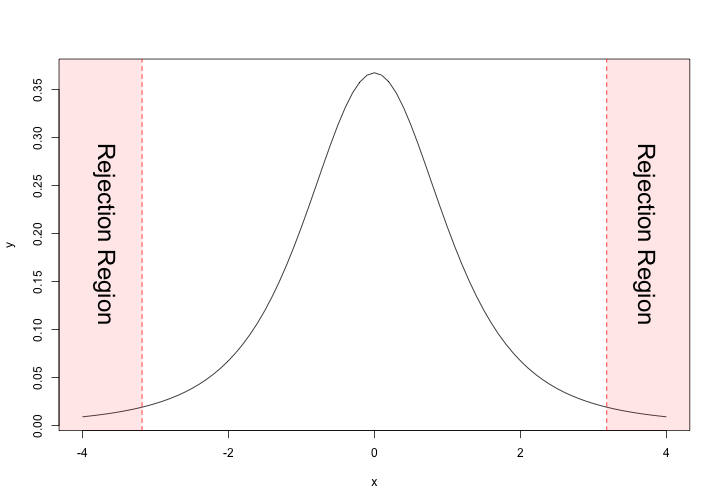R1 Lecture 10 Class Notes
By YU, Xiang
May 5 2015
假设检验: 均值
Student’s t-test
One-sample t-test
理论基础
1.为了做单样本t检验,需要计算 t 统计量的值:
x¯
是样本均值(sample mean),
s
是样本标准差(sample standard deviation),
2.需要计算在给定的 α 下, t−statistic 允许的取值范围
x <- seq(-4,4,0.1)
y <- dt(x,3)
plot(x,y,type="l")
abline(v=c(qt(0.025,3),qt(0.975,3)),col="red",lty=2)
rect(-5,-0.1,qt(0.025,3),0.4,border=FALSE,col=rgb(1,0,0,0.1))
rect(qt(0.975,3),-0.1,5,0.4,border=FALSE,col=rgb(1,0,0,0.1))
text(c(-3.7,3.7),c(0.2,0.2),"Rejection Region",srt=-90,cex=2)3.若 t−statistic 在允许范围内,则接受原假设;否则拒绝原假设,接受备择假设
参考程序
my_t_test <- function(sample,mu,alpha=0.05){
t_stat <- (mean(sample)-mu)/sd(sample)*sqrt(length(sample))
q1 <- qt(alpha/2,length(sample)-1)
q2 <- qt(1-alpha/2,length(sample)-1)
if(t_stat > q1 & t_stat < q2){
print("Accept the NULL Hypothesis")
}
else{
print("Reject the NULL Hypothesis")
}
}一个检验的例子
# 使用iris数据集测试
str(iris)## 'data.frame': 150 obs. of 5 variables:
## $ Sepal.Length: num 5.1 4.9 4.7 4.6 5 5.4 4.6 5 4.4 4.9 ...
## $ Sepal.Width : num 3.5 3 3.2 3.1 3.6 3.9 3.4 3.4 2.9 3.1 ...
## $ Petal.Length: num 1.4 1.4 1.3 1.5 1.4 1.7 1.4 1.5 1.4 1.5 ...
## $ Petal.Width : num 0.2 0.2 0.2 0.2 0.2 0.4 0.3 0.2 0.2 0.1 ...
## $ Species : Factor w/ 3 levels "setosa","versicolor",..: 1 1 1 1 1 1 1 1 1 1 ...my_t_test(iris[1:50,1],5)## [1] "Accept the NULL Hypothesis"my_t_test(iris[1:50,1],7)## [1] "Reject the NULL Hypothesis"当然,普通青年会选择使用 R package:stats 中的 t.test
Description:
Performs one and two sample t-tests on vectors of data.
Usage:
t.test(x, ...)
## Default S3 method:
t.test(x, y = NULL,
alternative = c("two.sided", "less", "greater"),
mu = 0, paired = FALSE, var.equal = FALSE,
conf.level = 0.95, ...)
## S3 method for class 'formula'
t.test(formula, data, subset, na.action, ...)# iris数据集中setosa和versicolor两类的Sepal.Length的均值是否相等
t.test(iris[1:50,1],iris[51:100,1])##
## Welch Two Sample t-test
##
## data: iris[1:50, 1] and iris[51:100, 1]
## t = -10.521, df = 86.538, p-value < 2.2e-16
## alternative hypothesis: true difference in means is not equal to 0
## 95 percent confidence interval:
## -1.1057074 -0.7542926
## sample estimates:
## mean of x mean of y
## 5.006 5.936# var.equal默认值为FALSE,此时使用 [Welch's t-test](http://en.wikipedia.org/wiki/Welch%27s_t_test)
# 如果已知两组数据方差相等,可修改 *var.equal=TRUE*
t.test(iris[1:50,1],iris[51:100,1],var.equal=TRUE)##
## Two Sample t-test
##
## data: iris[1:50, 1] and iris[51:100, 1]
## t = -10.521, df = 98, p-value < 2.2e-16
## alternative hypothesis: true difference in means is not equal to 0
## 95 percent confidence interval:
## -1.1054165 -0.7545835
## sample estimates:
## mean of x mean of y
## 5.006 5.936使用t-test的前提: 样本满足正态性
如何检验样本是否满足这一正态性假设?
Shapiro-Wilk Normality Test
Description:
Performs the Shapiro-Wilk test of normality.
Usage:
shapiro.test(x)shapiro.test(iris[1:50,1])##
## Shapiro-Wilk normality test
##
## data: iris[1:50, 1]
## W = 0.9777, p-value = 0.4595shapiro.test(iris[51:100,1])##
## Shapiro-Wilk normality test
##
## data: iris[51:100, 1]
## W = 0.9778, p-value = 0.4647作业
写一个函数,完成两独立样本的t检验(样本容量可相等可不相等,方差相等)
my_t_test2 <- function(sample_1,sample_2,alpha=0.05){
...
}可以参考以下公式:
t=X1¯−X2¯sX1X2⋅1n1+1n2‾‾‾‾‾‾‾‾√
sX1X2=(n1−1)s2X1+(n2−1)s2X2n1+n2−2‾‾‾‾‾‾‾‾‾‾‾‾‾‾‾‾‾‾‾‾‾‾‾‾√























 627
627

 被折叠的 条评论
为什么被折叠?
被折叠的 条评论
为什么被折叠?








